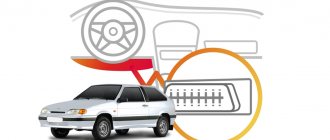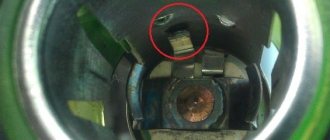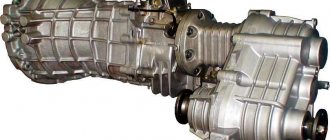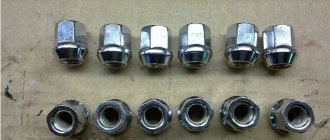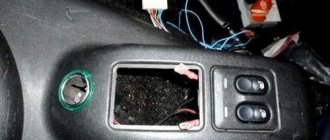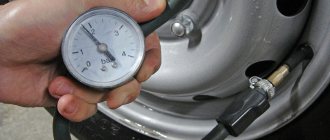OBD 2 pinout
The 12-pin OBD1 in the Chevrolet Niva has been replaced by OBD2.
This is due to the introduction of new standards in Europe since 2001. This solution has significantly expanded the possibilities of car diagnostics. The first copies of the equipment showed general error information. Using OBD2, the car owner can independently obtain complete information on the state of the ECU by using a scanning device or adapter. 16-pin connector. Its shape has changed: now it is a trapezoid with a narrowing downwards.
The plug contacts are responsible for the following diagnostic elements:
- pin 2 - bus+ (via J1850);
- 4 — body grounding;
- 5 - signal grounding;
- 6 - CAN-High line (via J-2284 protocol);
- 7 - K-Line;
- 10 — bus- (via J1850);
- 14 - CAN-Low line (via J-2284 protocol);
- 15 — L-line;
- 16 - battery powered.
Car brands and years of manufacture
OBDII has been used in cars since 1996 in the USA. In Europe, standards changed in 2001. In the Chevrolet Niva, new diagnostic connectors first appeared in the 2002-2019 models. These cars work with control systems BOSCH MP7.0 Euro-3, BOSCH M7.9.7, January-7.2, January-7.3.
Diagnostic connector pins for used protocols
The OBDII standard suggests the possibility of using 5 diagnostic protocols . Chevrolet Niva uses 3 of them:
- J1850 PWM. High-speed protocol with a performance of 41.6 Kb/sec. Transmits signals via pins 2, 4, 5, 10, 16.
- J1850 VPW. (The principle) of transmitting signals via pins 2, 4, 5, 16 is the same, but the speed is 10.4 Mb/s.
- ISO 9141-2. The simplest protocol that does not require complex communication microprocesses (unlike the above). Performs pulse transmission using pins 4, 5, 7, 15, 16
Features: The ISO 9141-2 protocol is easy to determine, thanks to pin 7, as well as the exclusion of pin 2 (10) on the Chevy Niva diagnostic connector.
If the system does not have pin 7, the SAE J1850 VPW (Variable Pulse Width Modulation or Pulse Width Modulation) protocol is used. The specified signal transmission protocols function properly via a standard OBD-II J1962 connector cable.
Methods for checking a knock sensor
If the first signs of malfunction of the DD appear, then before making a decision on replacement, it is necessary to check the performance of the meter
First of all, you should pay attention to whether there is an error on the on-board computer screen. If the DD produces too high or low a signal level, this is detected electronically and the driver receives an alert
Also interesting: VAZ Niva repair, generator check
You can accurately check the serviceability of the DD only on a stand. All other methods only indirectly indicate the performance of the device.
First of all, it is important to check the resistance between the contacts. In normal condition it should be about 5 MOhm
Any significant deviation indicates a malfunction of the meter.
Another test method is to measure voltage. To do this you should:
Remove the sensor. Connect a multimeter or voltmeter to the terminals. Using a small metal object, such as pliers or a bolt, tap the working torus of the meter. Check the information on the device. If there are no voltage surges, then the sensor is unsuitable for further use.
It is important to take into account that even if there are voltage surges, this is not a reason to consider the DD to be fully operational. The ECU operates in a narrow range of amplitudes and frequencies, the correspondence of which cannot be detected with a multimeter or voltmeter.
In order to independently change the knock sensor on a Chevrolet Niva, you must follow the instructions below.
Disconnect the terminal block.
Move the connector to the side so that it does not interfere with further dismantling.
- Using a 13mm wrench, unscrew the DD fastening bolt.
- Remove the sensor.
- Install a new sensor.
- Connect the connector.
OBD 1 pinout
To correct the operation of electronic systems, OBD equipment was invented. The first generation pinout has a rectangular shape with 12 pins.
Each of the elements of the nest has its own purpose:
- pin A transmits mass information;
- B corresponds to the diagnostic L-line;
- D—CO potentiometer;
- contact G is responsible for the fuel pump control functions;
- H—food;
- M - K-Line diagnostics.
At the bottom of the pinout there is a “Key”, which is responsible for maintaining the correct design of the equipment. This element is designed to ensure the correct orientation of the plug and connector in the car.
Car brands and years of manufacture
Any injection model before 2002 has an OBD1 pinout. When determining the type of diagnostic connector for 2002 cars, it is worth considering that some may already use OBD2. They can be easily distinguished by their “rosette” shape.
Access and location
To find OBD1, just look behind the steering column - where the ignition switch is located. The connector is accessible to the driver.
Where is the diagnostic connector located on a Chevrolet Niva?
The classic location of the diagnostic connector block in most cars is behind the steering wheel near the ignition switch. Chevy Niva is no exception. The OBD type pinout is used. On-board diagnostics of the first generation was developed back in 1991 with the purpose of reading information on the state of the ECU (electronic control unit). This system is responsible for all engine functions.
The first copies of Niva Chevrolet used a 12-pin OBD1 connector. Since 2002, it was changed to 16-pin OBD2. To select the correct diagnostic equipment for the on-board computer, you need to find out in advance what type of pinout is in a particular Chevrolet Niva.
Selecting equipment for diagnosing Niva Chevrolet
The first step when choosing a cable for reading information from an on-board computer is determining the type of connector.
The main difference between OBDI and OBDII (besides the year of manufacture of the vehicle in which it is installed) is the shape of the connector. How to determine what type of pinout is used in a particular car is described in detail above. It is also possible to connect the K-Line connector to the OBD connector on the Niva Chevrolet. In this way, special diagnostic equipment is installed.
To read information from the OCU you will need:
- a scanning device that supports the required type of connections (currently, in addition to traditional equipment operating via a USB cable, there are items that support wi-fi and bluetooth functions);
- laptop;
- adapter (if necessary);
- appropriate software for diagnostics (for the Russian automotive industry, the ScanMaster ELM 2.1 and OpenDiagPro programs are recommended).
Important! The computer must support the same types of information transfer as the adapter. Otherwise, connection will not be possible.
There is a wide range of diagnostic equipment on the modern market . It is divided into the following types:
- "amateur" equipment;
- multi-brand (multifunctional) devices;
- professional equipment.
Replacing brushes or the generator itself
Current collection brushes wear out most often, so here is a description of how to do this job:
- Remove the negative terminal from the battery and disconnect the wires leading from the generator casing.
- Remove the protective cap from the terminals of the positive terminal of the wires. Unscrew the nut that secures the block to the generator block.
- Disconnect the spring clips and remove the black plastic cover.
- Unscrew the voltage regulator mountings with a Phillips screwdriver. Take it out along with the brushes.
- Disconnect the wires from it. Remove the assembly together with the fastening bar, take off the belt.
- Release the generator from the bracket by unscrewing all the mounting bolts.
The further plan of action depends on what you will change. If the brushes are very worn, they need to be replaced. If the current collectors are visually intact, then the reason may be in other parts of the generator. In most cases, car enthusiasts simply change it entirely.
Location of the diagnostic connector in VAZ cars
Installation with a standard VAZ connector and the OBD II standard is also possible. Types of diagnostic cords for data transfer. The NPP NTS cord is equipped with KR2 adapters with a triple core, in which 2 wires are dedicated for connection to the battery using crocodiles and an additional signal cable connected to the contact block.
If you need to extend the wire yourself, remember that the maximum length should be no more than 15 meters so as not to create unnecessary interference.
And, undoubtedly, the most convenient to use is the model with a built-in Kline type adapter. If there is a standard location, then it is connected to the diagnostic line between the ECU and the immobilizer.
And if it is missing, a plug is installed in its place.
To restore the connection between the contacts, a jumper is installed, as shown in the picture below: Depending on the year of manufacture of the model, the connectors may differ from each other. Self-diagnosis If it is not possible to check with a special device, then this can be done using self-diagnosis, which will help to quickly identify all problems associated with the operation of the car.
The speedometer needle will begin to rise to the top; by pressing again, information about the firmware will appear on the screen, and by pressing again, all existing errors will appear. Let's take a closer look at Chevrolet Niva error codes with decoding: As practice shows, knowing how to perform an independent check is very useful, since this knowledge helps to quickly identify a malfunction and eliminate it in a timely manner.
Check engine error If the check engine light comes on on a Niva Chevrolet, this warns that there are malfunctions related to engine operation. The light comes on at the moment when the engine begins to detect a failure or error and writes a specific code into its memory.
Auto scanner for Chevrolet Niva
https://youtube.com/watch?v=Zo6TM4mdFKg
Let's look at the main reasons why this warning may appear: The fuel-air mixture has an incorrect composition. This problem is eliminated by filling the tank with higher quality gasoline.
VAZ-21214 car. Reading codes
A – contact connected to ground;
B – diagnostic contact for sending a signal to the controller; G – electric fuel pump control contact; M – information output contact (serial data channel) The diagnostic block is used for communication with the controller. It is located under the glove compartment on the right side next to the controller.
Fault codes stored in the controller's memory can be read either with a special diagnostic tool or by counting the number of flashes of the "CHECK ENGINE" lamp.
Issuance of code 12 by the “CHECK ENGINE” indicator lamp
To read the codes with a lamp, you must connect contact “B” of the diagnostic block to ground. The easiest way is to short it to ground by connecting it to contact “A”, which is connected to engine ground.
When contacts “A” and “B” are connected to each other, the key in the ignition switch must be turned to position III (Ignition), but the engine should not run.
Under these conditions, the “CHECK ENGINE” lamp should flash code 12 three times in a row. This should happen in this order: flash, pause (1-2 s), flash, flash - long pause (2-3 s), and so on twice.
Code 12 indicates that the controller diagnostic system is working. If code 12 is not displayed, then there is a problem with the diagnostic system itself.
After code 12 is displayed, the CHECK ENGINE lamp displays fault codes three times, if they exist, or simply continues to display code 12 if there are no fault codes. If more than one fault code is stored in the controller’s memory, they are displayed 3 times each.
Warning Upon completion of the diagnostics, it is allowed to open contacts “A” and “B” of the diagnostic block 15 seconds after turning off the ignition.
Source
What problems may be hidden in the Chevrolet Niva generator
If you are sure that the battery is in good condition and produces sufficient voltage, then you need to diagnose the generator. It is one of the weak points of the Chevrolet Niva. During its diagnostic process, malfunctions may be detected:
- pulley wear or damage;
- wear of current collecting brushes;
- rectifier failure;
- failure of the voltage regulator;
- destruction or wear of the bearing;
- wires are damaged;
- collector wear.
Before dismantling, you can check the generator by paying attention to the headlights and other signs. The malfunction is present in the following situations:
- headlights burn dimmer than usual;
- while the engine is running, the battery discharge lamp lights up or flashes on the dashboard;
- as engine speed increases, the brightness of the headlights changes;
- spontaneous shutdown of the radio;
- rapid battery drain.
If you have these problems, you need to replace the generator or its parts. We will give examples of how to install new brushes on this unit or replace it entirely.
Types of diagnostic cords for data transmission
The NPP NTS cord is equipped with KR2 adapters with a triple core, in which 2 wires are separated for connection to the battery using crocodiles and an additional signal cable connected to the contact block. If you need to extend the wire yourself, remember that the maximum length should be no more than 15 meters so as not to create unnecessary interference.
And, undoubtedly, the most convenient to use is the model with a built-in Kline type adapter. It allows easy connection to a laptop and is compatible with many special applications for car diagnostics.
Diagnostic equipment in Chevy Niva: connection
Diagnostics of the on-board computer of a car involves special diagnostic equipment, usually connected to a laptop or computer. In turn, data transmission is usually provided by the COM port, where the K-Line connector is connected.
When connecting the Chevrolet Niva to the equipment, it is possible that an error may occur on the PC monitor. Mostly, the diagnostic device provides information about the unavailability of communication with the microcontroller. However, there is no need to panic. There are many reasons for this. First of all, you need to find out whether the car has an immobilizer system. If available, you need to examine the adapter itself. When this is not possible, you need to diagnose the system for the presence of breaks. The latter are found in the wiring, where the connector and the ECU line are located.
In a standard placement, the diagnostic line can be connected to the ECU and immobilizer connector. If the latter is not available, the diagnostic line is completely shielded. The connector connection point is equipped with a plug. To restore communication, install a jumper or immobilizer between the contacts.
It is worth noting that the location of the connector may differ in different car models produced by the AvtoVAZ concern. A device for connecting electrical circuits may be located under the hood. In models with a low dashboard, it is installed in the cabin next to the glove compartment. With a high panel - in the area of the center of the dashboard. In Chevrolet, the diagnostic connector is located near the ignition switch.
To detect it, you need to pay attention to the steering column cover
As mentioned, the ECU is located under the glove compartment, near the passenger's feet. To gain access to it, you will need to remove the glove box and the fuse box fasteners. If you have a long cable, it is not necessary to remove the fasteners.
Thus, the main advantage of a diagnostic troubleshooting system is time saving. In addition, the results are usually very accurate, therefore, the repair will be as productive as possible.
Since a computer is considered the same device, it sometimes has failures. The PC is sometimes not able to detect a breakdown in the motor, which means you should not count on this diagnosis 100%. It is very rare, but it still happens that the computer indicates a breakdown of the entire system, but in fact you should literally tighten the nut.
In conclusion, we note: it is necessary to know the location of the diagnostic connector located in the Chevrolet Niva, because it is precisely this that helps in checking the car for damage quickly and efficiently. And all this becomes possible thanks to computer diagnostics.
Connecting diagnostic equipment to the car
Archival article.
2001 – 2003. To connect the car to a personal computer, it is necessary to purchase or manufacture a communication interface between the COM port and the K‑LINE diagnostic connector.
The first message on the screen of diagnostic equipment or a computer that causes panic among beginners is usually something like “No connection”, “No controller response” or something similar, but no less intriguing. The motor tester, for example, begins to offer options - from unconnected power to a hardware malfunction of the adapter. It’s good if the car with the immobilizer was the first to arrive for diagnostics and you are sure that everything is in order with the adapter. The reason for the lack of communication on cars without immo is trivial and is possible only in the domestic auto industry - a break in the diagnostic line running from the diagnostic connector to the ECU. The immobilizer uses K‑Line to communicate with the ECU and is included in the diagnostic line break. If the immobilizer is not installed, then the diagnostic line hangs in the air and there is no connection with the computer. Apparently there was supposed to be a plug in this place, but... To restore communication, you just need to install a jumper between pins 9 - 1 and 18 of the immobilizer connector (or install the immobilizer) as shown in the figure. In practice, to preserve the functions of smooth dimming of light, and simply to scare away pioneers, these two wires are cut and spliced, leaving the immo in the connector.
| GAS diagnostic connector. 1 +12V 2 +12V from battery 10 L‑Line 11 K‑Line 12 Ground | Diagnostic connector VAZ | |||||
| A – GND B – L‑Line (may not exist) M – K‑Line G – Fuel pump control. | ||||||
| H – 12V. Constant from the battery through a fuse. /may not be. | ||||||
| The latest modifications of the VAZ, designed for EURO 3 (4) toxicity standards, use the standard European OBD-II connector. | ||||||
| Assignment of diagnostic block contacts | ||||||
| 2 – J1850 Bus+ 4 – Chassis Ground 5 – Signal Ground 6 – CAN High (J‑2284) 7 – ISO 9141 – 2 K Line | 14 – CAN Low (J‑2284) 15 – ISO 9141 – 2 L Line 16 – Battery Power | |||||
| Location of diagnostic pads VOLGA - under the hood, on the wall of the engine compartment, on the passenger side VAZ 2110 - to the right of the driver, next to the steering column of the VAZ 2109 Low panel - on the shelf under the glove compartment, next to the VAZ 2109 ECU High panel - behind the center console. VAZ 2108 – 2115 “Europanel” – on the “dashboard”, closed with a hatch. Chevrolet Niva – OBD-II, approx.
Block arrangement | Chevrolet Niva - control unit
| |||||
| VAZ 2106i - The control unit is located in the place of the shelf under the glove compartment, where the ECU fuses, diagnostic block and PTF relay are located. All this is closed in a purely domestic way, with a plastic shield with huge gaps. To connect the diagnostics, the shield will have to be unscrewed, because despite its “flexibility”, it is not possible to insert the diagnostic connector. | ||
| VAZ 11183 "Kalina" | VAZ 21126 "Priora" | |
This design was developed by NPP NTS to connect its diagnostic equipment. In a slightly modified form, these connectors can be found at car markets in Togliatti. This drawing was produced and provided by ©AIST
The connector shown in the photo can be purchased in Togliatti at the “Plamya” car market. It is made quite well and has one undoubted advantage - the presence of a fairly large amount of free space. For example, I could easily fit the k-line adapter in it. The result is a compact adapter for a laptop.
But such a block for connecting to the dianostics connectors can be ordered online on the website of the Togliatti company ZAPCHAST - SERVICE. The block is a plastic double-sided connector, on one side of which there is a connection to the standard VAZ diagnostic block, on the other - OBD II. I have already ordered them several times, delivery by parcel post (to Volgograd) within a week.
How to make connectors for connecting to diagnostic connectors yourself? Sany77 shares his manufacturing experience -
Diagnostic cords
Now a little about the cord. NPP NTS, for example, equips its KR-2 adapters with a 3-wire harness 5 meters long, two supply power (“+” and “-” from the battery, crocs) and one unshielded signal wire connected in the block to the “M” contact " When making the cord yourself, you need to keep in mind that when using high-quality shielded wire, the length can be increased to 15 m, and that a system with a separate power supply was chosen due to the fact that in older types of wiring power was not supplied to the diagnostic block - at present Now you can connect everything directly to the block. The photographs show “replacement” cords for VAZ and GAZ with power supply from the adapter from the diagnostic block.
And, undoubtedly, the most convenient to use when using a laptop is a block with a built-in K‑Line adapter. The adapter shown in the photo on the left is actively used for diagnostics and work with the J5 On-line tuner engineering ECU in conjunction with an IBM Thinkpad P‑II/366 laptop. A diagnostic block of this type can be found in Tolyatti, the Flame market, or made
.
In conclusion, we present the pinout of the adapters: 1. The most popular K‑Line from chiptuner.ru - it fully corresponds to the pinout of the KR‑2 adapter from NPP NTS: 2‑K-Line, 4.5 + power, 8.9 – GND.
2. Adapter K‑Line v.1.7: 9‑pin from Auto Electrician: 1 – K‑Line, 4 – K‑Line ground, 5 – power ground, 8 – power plus.
3. Adapter K‑L-Line v.2.1 (and from USB K‑L-Line) from Autoelectric: 1.14 – K‑line; 13.25 L‑Line; 17.18 +12V; 21.22 GND; 3 – J1850 Bus+
Typical breakdowns
Be sure to listen to how the engine operates as the load increases - if even the slightest metallic clatter appears, be sure to make a diagnosis.
Otherwise, you may experience the following problems:
- Burnout of the gasket under the cylinder head. When detonation occurs, the engine temperature increases.
- Destruction of the pistons, as they all corrode.
- Very often, elements of the crank mechanism and cylinder head are destroyed.
If you are driving your car up a hill and the gear is in high gear, be sure to monitor the engine. If you subject the engine to heavy loads, you will contribute to the appearance of detonation knocks. As a result, many elements of the car will fail, and this is the first step towards a major overhaul.
What problems may be hidden in the Chevrolet Niva generator
If you are sure that the battery is in good condition and produces sufficient voltage, then you need to diagnose the generator. It is one of the weak points of the Chevrolet Niva. During its diagnostic process, malfunctions may be detected:
- pulley wear or damage;
- wear of current collecting brushes;
- rectifier failure;
- failure of the voltage regulator;
- destruction or wear of the bearing;
- wires are damaged;
- collector wear.
Before dismantling, you can check the generator by paying attention to the headlights and other signs. The malfunction is present in the following situations:
- headlights burn dimmer than usual;
- while the engine is running, the battery discharge lamp lights up or flashes on the dashboard;
- as engine speed increases, the brightness of the headlights changes;
- spontaneous shutdown of the radio;
- rapid battery drain.
Where is the Chevrolet Niva diagnostic connector located?
The main advantage of such a breakdown detection system is the huge savings in time that could have been spent searching for breakdowns. The results are always very accurate, so the repair plan will be as effective as possible.
Such diagnostics are developing very rapidly, and the developments of professionals are leading to such a method of troubleshooting becoming the main one.
To carry out such a diagnosis, not much is needed, namely:
- computer near the car;
- K-Line adapter;
- extension cord from the outlet to the car;
- special programs.
To carry out such diagnostics, you need to find the computer connector in the car. Its location differs in different cars. It can be located both under the hood and inside the car.
As you can see, it is necessary to know the location of the diagnostic connector in your car, since it is this that helps to check the car for malfunctions very quickly and efficiently thanks to such a development as computer diagnostics.
We diagnose a Chevrolet Niva ourselves - where is the diagnostic connector located?
For self-diagnosis of a Chevrolet Niva, you need an ELM327 and an Android . You can also carry out diagnostics using a wired adapter and a laptop. But in this article we will talk specifically about using the mobile diagnostic option.
The location of the connector is indicated by an arrow.
Diagnostic equipment in Chevy Niva: connection
Diagnostics of the on-board computer of a car involves special diagnostic equipment, usually connected to a laptop or computer. In turn, data transmission is usually provided by the COM port, where the K-Line connector is connected.
When connecting the Chevrolet Niva to the equipment, it is possible that an error may occur on the PC monitor. Mostly, the diagnostic device provides information about the unavailability of communication with the microcontroller. However, there is no need to panic. There are many reasons for this. First of all, you need to find out whether the car has an immobilizer system. If available, you need to examine the adapter itself. When this is not possible, you need to diagnose the system for the presence of breaks. The latter are found in the wiring, where the connector and the ECU line are located.
In a standard placement, the diagnostic line can be connected to the ECU and immobilizer connector. If the latter is not available, the diagnostic line is completely shielded. The connector connection point is equipped with a plug. To restore communication, install a jumper or immobilizer between the contacts.
As mentioned, the ECU is located under the glove compartment, near the passenger's feet. To gain access to it, you will need to remove the glove box and the fuse box fasteners. If you have a long cable, it is not necessary to remove the fasteners.
Thus, the main advantage of a diagnostic troubleshooting system is time saving. In addition, the results are usually very accurate, therefore, the repair will be as productive as possible.
Since a computer is considered the same device, it sometimes has failures. The PC is sometimes not able to detect a breakdown in the motor, which means you should not count on this diagnosis 100%. It is very rare, but it still happens that the computer indicates a breakdown of the entire system, but in fact you should literally tighten the nut.
In conclusion, we note: it is necessary to know the location of the diagnostic connector located in the Chevrolet Niva, because it is precisely this that helps in checking the car for damage quickly and efficiently. And all this becomes possible thanks to computer diagnostics.
ELM327 Niva, specifics
Bluetooth adapters ELM327
When I became concerned about this problem, I attracted an electronics engineer friend of mine, who is very, very meticulous in his profession. He immediately told me the following phrase: China and China are different. I have already tried to convey this idea to the people in an article about rear brake pads . On the current issue, we ordered several samples directly from the FACTORIES and began to slowly mock them, open them and break them. I won't wait long. Only ONE adapter connected normally with the fields and shnives. In the photo, he is in the middle. The rest either did not communicate with the smartphone or did not connect to power at all. Even my branded Konnwey adapter (far right), which sees almost the entire Japanese fleet and half of Europe, did not want to communicate with the fields.
Attention. The main and main function of this Bluetooth adapter ELM327 Niva is only one - to view and erase errors and turn off the “check engine on the panel” light. You can't do anything else on a wireless device. If you want to make friends with the engine more seriously, the tool must be different. A wired USB adapter (possibly with the same ELM327 chip) and a laptop with more serious diagnostic programs.
Diagnostic equipment in Chevy Niva: connection
Diagnostics of the on-board computer of a car involves special diagnostic equipment, usually connected to a laptop or computer. In turn, data transmission is usually provided by the COM port, where the K-Line connector is connected.
When connecting the Chevrolet Niva to the equipment, it is possible that an error may occur on the PC monitor. Mostly, the diagnostic device provides information about the unavailability of communication with the microcontroller. However, there is no need to panic. There are many reasons for this. First of all, you need to find out whether the car has an immobilizer system. If available, you need to examine the adapter itself. When this is not possible, you need to diagnose the system for the presence of breaks. The latter are found in the wiring, where the connector and the ECU line are located.
In a standard placement, the diagnostic line can be connected to the ECU and immobilizer connector. If the latter is not available, the diagnostic line is completely shielded. The connector connection point is equipped with a plug. To restore communication, install a jumper or immobilizer between the contacts.
As mentioned, the ECU is located under the glove compartment, near the passenger's feet. To gain access to it, you will need to remove the glove box and the fuse box fasteners. If you have a long cable, it is not necessary to remove the fasteners.
Thus, the main advantage of a diagnostic troubleshooting system is time saving. In addition, the results are usually very accurate, therefore, the repair will be as productive as possible.
Since a computer is considered the same device, it sometimes has failures. The PC is sometimes not able to detect a breakdown in the motor, which means you should not count on this diagnosis 100%. It is very rare, but it still happens that the computer indicates a breakdown of the entire system, but in fact you should literally tighten the nut.
In conclusion, we note: it is necessary to know the location of the diagnostic connector located in the Chevrolet Niva, because it is precisely this that helps in checking the car for damage quickly and efficiently. And all this becomes possible thanks to computer diagnostics.
Diagnostics of Niva Chevrolet
The Chevrolet Niva diagnostic connector helps you obtain information about how most units work, into which special equipment is connected via Bluetooth or a cable. Therefore, if you want to conduct independent diagnostics, it is important to know where it is.
The connector in the Niva is located under the steering wheel on the right side, and the pinout itself is under the dashboard on the driver’s side. To check the on-board computer, you need to use special equipment that transmits all the necessary information to the laptop. Data transfer is carried out using a COM port into which a K-LINE type connector is installed.
When connecting, errors may appear on the laptop screen. At this moment, there is no need to worry, since the appearance of such messages may be due to a lack of communication with the device itself. You should also check whether the standard anti-theft system is installed; if so, check the adapter itself. If there is a standard location, then it is connected to the diagnostic line between the ECU and the immobilizer. And if it is missing, a plug is installed in its place. To restore communication between the contacts, a jumper is installed, as shown in the picture below:
Depending on the year of manufacture of the model, the connectors may differ from each other.
- 1 Self-diagnosis
- 2 Check engine error
- 3 Chip tuning
- 4 Summary
Check engine error
If a check light comes on on a Niva Chevrolet car, this warns that there are malfunctions associated with the operation of the engine. The light comes on at the moment when the engine begins to detect a failure or error and writes a specific code into its memory.
Let's look at the main reasons why this warning may appear:
- The air/fuel mixture is incorrect. This problem is eliminated by filling the tank with higher quality gasoline.
- Low engine oil level
- Engine overheated
- There are problems with the ignition system, which may be due to a faulty spark plug or ignition coil
- The power system is faulty. It is possible that fuel injection into one of the cylinders has stopped.
- Lambda probe faulty
- A separate sensor in the ECM system has failed
We can conclude that in some cases, when the engine starts and the check light is on, this may indicate that the engine is operating in emergency mode and the problem is not very critical. If the engine starts and stalls, then this is most likely a problem with the fuel supply or the crankshaft sensor has failed.
In any case, it is better not to use the car until you find out the exact reason.
Chip tuning
Some drivers do chip tuning of the Chevrolet Niva in order to increase engine power. The essence of this procedure is to remove the established restrictions by adjusting the optimal factory settings in the electronic control unit. This procedure helps to extract the additional performance inherent in the motor.
The whole process can be divided into several stages:
- Reading the necessary data from the electronic control unit
- Making the necessary adjustments
- Updating and recording new data
The main advantage of this procedure is:
- Engine power increases
- Speed limit removed
- You can change the fuel type
- All factory settings can be returned at any time
Chevrolet Niva error diagnosis
The most reliable way to identify what is wrong with a car is to diagnose electrical appliances and equipment. The procedure allows you to accurately identify breakdowns and quickly repair your car.
There are two ways to detect a problem in a car.
Self-diagnosis VAZ 2123
The simplest procedure allows the motorist to independently identify the damaged area and repair the damage. Thanks to the successful firmware of the on-board computer, some errors are displayed on the standard display. In this case, nothing happens on its own - you will need to perform several steps manually:
- turn off the engine and turn off the ignition;
- find the daily mileage reset button on the dashboard and press it;
- at the same time turn the key in the starting cylinder;
- if everything is done correctly, all the indicators on the dashboard will light up, and the instrument arrows will make a full circle and return to their place;
- at the same time, the firmware version of the on-board computer will be reflected on the built-in display;
- The next press of the key will display a network error.
If the manipulations are correct, one of the indicated codes will appear on the display, and each Niva Chevrolet error number will be responsible for its own section of the highway:
- 0 – error 0 Niva Chevrolet indicates that there are no problems in the on-board circuits; most likely, the breakdown is purely mechanical in nature;
- 1 – standard error of the Niva Chevrolet ECU – the processor is not working correctly;
- 2 – for a Chevrolet Niva, error 2 indicates a lack of power to the gas tank float;
- 4 – malfunction of the battery or generator; a critical excess of the rated voltage of more than 16 volts was detected in the on-board circuits;
- 8 – has the opposite meaning; on a Chevrolet Niva, error 8 indicates an excessive voltage drop in the wiring due to a deep discharge of the battery or a malfunction of the generator;
- 12 – error 12 Chevrolet Niva reports a breakdown of the control indicator;
- 13 – signal transmission from the lambda probe is disrupted, you need to check the device and main power lines;
- 14 – on Niva Chevrolet, error 14 indicates a critical antifreeze temperature, the system requires cooling, otherwise the power unit may boil;
- 15 – the motor is too cold for normal operation, usually the error disappears after a good warm-up or replacement of the sensor;
- 19 – malfunction of the DPKV, the encoding indicates an incorrect speed of rotation of the unit;
- 21/22 – the throttle position differs from the calculated values up/down;
- 23/25 – the air mixture on the intake manifold is excessively cooled or overheated;
- 24 – open circuit of the speedometer, accompanied by a lack of response of the instrument needle to the driver’s manipulations;
- 27/28 – incorrect display of the actual amount of exhaust from the calculated value;
- 33/34 – Mass air flow sensor, the indicators of the device are overestimated or underestimated, relative to the actual state of the system;
- 35 – incorrect operation of the engine at idle, you need to check the correctness of the mixture formation settings;
- 41 – the phase distribution sensor or DPRV has detected an open circuit or the data received is erroneous;
- 42 – multiple misfires were detected, the system turned off the fuel supply to the damaged cylinders;
- 43 – the detonation channel sensor generates an error;
- 44/45 – fuel mixture is too rich/lean; you need to check the fuel lines for mechanical damage;
- 49 – the vacuum gauge is out of order or overloaded;
- 51 – ROM has failed, or there is a breakdown in the power cables;
- 52 – RAM is not working correctly, damaged, no power;
- 53 – the adsorber purge valve is faulty;
- 54 – octane corrector controller is de-energized or broken;
- 55 – the calculated load on the internal combustion engine differs from the established one;
- 61 – the oxygen quantity controller in the intake system transmits incorrect data to the computer.
At the same time, you need to accurately understand that, for example, when error 10 is on the display, the Chevrolet Niva tells the driver that there are several problems (standard, unambiguous codes are summed up).
You should also know that Niva Chevrolet self-diagnosis errors do not reflect the exact location of the breakdown. Codings can only show the section of the wiring where you need to look for the cause of the malfunction. Also, these encryptions may be the result of a software failure after an unsuccessful wash or disconnection of the battery. To obtain more accurate data, the user needs to connect a special diagnostic scanner.
Niva sensors
As you know, the first Russian SUV Niva was born back in the days of the Soviet Union. At that time, in the USSR they did not even think about an electronic engine control system; the entire process of operation of the internal combustion engine was mechanical. The engine was supplied with fuel through a carburetor. At present, the Niva still continues to be produced, but with its ancestors, the modern Niva has only the body left and it has undergone minor modifications.
The carburetor was replaced with an injector, the interior was changed and the appearance of the car was transformed, but still the Niva remained Niva. The legendary Niva cross-country ability did not deteriorate after these modifications, but became much more comfortable.
In this article we will talk about the sensors of the engine control system in the injection Niva, namely, it describes in detail each of the sensors, where it is located and what function it is responsible for, as well as the signs of sensor malfunction are described in detail.
Electronic engine control unit (ECU)
An ECU is a kind of computer in a car; it is in this device that the entire operation of the internal combustion engine is corrected. All sensors that are installed in the car transmit readings specifically to this unit, and based on the readings, it makes changes to the operation of the engine, which affects both the engine speed and its consumption.
Symptoms of ECU malfunction:
There can be a huge number of signs of malfunction of this unit, because signs of failure of one sensor may even indicate failure of the unit.
Mass air flow sensor (MAF)
This sensor is located near the Niva air filter box. Air flows through this sensor, which is necessary to form the air-fuel mixture. The sensor records the amount of air passing through it and sends signals to the electronic engine control unit (ECU).
Signs of a DMRV malfunction:
- Loss of vehicle dynamics;
- Increased fuel consumption;
- Unstable idling (speeds fluctuate);
- Difficulty starting the engine when the engine is warm;
The Niva DPKV is installed in a special hole in the oil pump drive cover. This sensor is responsible for setting the ignition timing.
The sensor takes readings from the crankshaft pulley, which has teeth and in one of the places there is “caries”, that is, several pulley teeth are missing. It is “caries” that the DPKV understands in what position the crankshaft is.
The sensor itself resembles an inductive coil, which generates impulses when the crankshaft rotates and transmits them to the computer.
If the sensors fail, the car will not start.
Signs of DPKV malfunction:
- The car does not start;
- The car stalls spontaneously;
- Uneven operation of the internal combustion engine;
DTOZH on Niva is installed in the cylinder head outlet pipe. The coolant temperature sensor is a fairly simple element in its design. The sensor is based on a thermistor, which changes its resistance as the temperature changes.
One of the functions of the sensor is to start the electric engine cooling fans when the coolant temperature threshold is reached. The sensor is also responsible for starting the engine in cold weather; according to the coolant temperature readings, the electronic control unit forms the fuel mixture necessary for more proper warming up of the car engine. This can be replaced by the presence of high warm-up speeds at the moment of starting the internal combustion engine.
Signs of DTOZh malfunction:
- Cooling fans do not work;
- No warm-up speeds;
- Difficulty starting the internal combustion engine;
- Increased fuel consumption;
The TPS is installed on the throttle itself and is a potentiometer. This sensor reads readings from the throttle position and transmits them to the ECU. The damper opens access to air, thereby increasing engine speed. When the damper opens, the sensor sends a signal to the control unit to increase the fuel supply, which is necessary to form a working air-fuel mixture.
The sensor that most often fails is an unreliable element of the system. Subsequently, they abandoned it and switched to an electronic throttle.
Signs of a malfunction of the TPS:
- High speed at start-up;
- Jumps in engine speed;
- Increased fuel consumption;
- Not smooth idle;
The knock sensor is installed on the right side of the vehicle's cylinder block. A DD is needed to catch detonations in the engine and adjust the fuel mixture. The sensor itself is made on the principle of a piezoelectric element and, in the presence of vibrations in the engine, transmits impulses to the ECU, which in turn adjusts the fuel mixture.
Signs of DD malfunction:
- Increased fuel consumption;
- Uneven operation at idle (increased vibrations);
- Jerks when the car moves;
The oil pressure sensor is located on the right side of the cylinder block and is screwed into the oil line fitting. This sensor is necessary to monitor the oil pressure in the engine. As you know, operating a car with low oil pressure in the internal combustion engine can damage it. When the oil pressure in the internal combustion engine decreases, the sensor closes the contact and sends a signal to the Niva instrument panel, lighting up the oil pressure indicator in the form of a red oil can.
Signs of DDM malfunction:
- Constant lighting of the oil pressure lamp;
- Oil leak from the sensor junction;
This sensor is located, just like the TPS, on the Niva’s throttle valve. The essence of the sensor's operation is to open and close the channels through which air flows to operate at idle speed. The IAC is involved in the operation of the internal combustion engine only at idle; when the speed increases, the regulator is switched off. IAC is a kind of DC motor with worm gear. Quite often the sensor fails. Subsequently, this sensor was abandoned in favor of an electronic throttle.
Signs of IAC malfunction:
- Lack of XX speed (engine stalls);
- Increased speed at idle;
- Increased fuel consumption;
The phase sensor, also known as the camshaft position sensor, is installed in the cylinder head plug. Designed for phased fuel injection. Reads readings from the camshaft and transmits them to the computer; these readings are necessary for accurate distribution of the fuel mixture between the cylinders.
Signs of DF malfunction:
- Increased fuel consumption;
- Increased engine vibrations;
The brake pedal sensor is installed on the pedal assembly under the Niva's steering column. In cars without the E-GAZ system, it is only responsible for turning the brake lights on and off. In cars that have an electronic throttle and therefore an electronic gas pedal, this sensor affects the operation of the pedal. If the brake sensor breaks down, the gas pedal stops working.
Signs of malfunction:
- The gas pedal does not work;
- Jerking when moving at a constant speed;
- Loss of power and vehicle dynamics;
The speed sensor of the Niva car is installed in the transfer case. The function of the sensor is to transmit vehicle speed readings. The sensor also forms the fuel mixture; when the car is moving at neutral speed, you can notice that the speed is slightly higher than when the car is running at XX while standing still. Increased speed when driving is necessary to avoid dips when turning on the speed and sharp acceleration.



